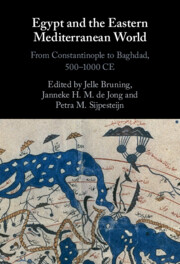Book contents
- Egypt and the Eastern Mediterranean World
- Egypt and the Eastern Mediterranean World
- Copyright page
- Contents
- Figures, Graphs, and Tables
- Notes on Contributors
- Notes on Transliteration, Names, and Dates
- Preface and Acknowledgments
- Additional material
- Introduction
- Part I Political and Administrative Connections
- Part II Economic Connections
- Part III Social and Cultural Connections
- Chapter 10 The Destruction of Alexandria: Religious Imagery and Local Identity in Early Islamic Egypt
- Chapter 11 Scribal Networks, Taxation, and the Role of Coptic in Marwanid Egypt
- Chapter 12 A Changing Position of Greek? Greek Papyri in the Documentary Culture of Early Islamic Egypt
- Chapter 13 Regional Diversity in the Use of Administrative Loanwords in Early Islamic Arabic Documentary Sources (632–800 CE): A Preliminary Survey
- Chapter 14 Babylon/Qaṣr al-Shamʿ: Continuity and Change at the Heart of the New Metropolis of Fusṭāṭ
- Chapter 15 Utilizing Non-Muslim Literary Sources for the Study of Egypt, 500–1000 CE
- Index
- References
Chapter 10 - The Destruction of Alexandria: Religious Imagery and Local Identity in Early Islamic Egypt
from Part III - Social and Cultural Connections
Published online by Cambridge University Press: 01 December 2022
- Egypt and the Eastern Mediterranean World
- Egypt and the Eastern Mediterranean World
- Copyright page
- Contents
- Figures, Graphs, and Tables
- Notes on Contributors
- Notes on Transliteration, Names, and Dates
- Preface and Acknowledgments
- Additional material
- Introduction
- Part I Political and Administrative Connections
- Part II Economic Connections
- Part III Social and Cultural Connections
- Chapter 10 The Destruction of Alexandria: Religious Imagery and Local Identity in Early Islamic Egypt
- Chapter 11 Scribal Networks, Taxation, and the Role of Coptic in Marwanid Egypt
- Chapter 12 A Changing Position of Greek? Greek Papyri in the Documentary Culture of Early Islamic Egypt
- Chapter 13 Regional Diversity in the Use of Administrative Loanwords in Early Islamic Arabic Documentary Sources (632–800 CE): A Preliminary Survey
- Chapter 14 Babylon/Qaṣr al-Shamʿ: Continuity and Change at the Heart of the New Metropolis of Fusṭāṭ
- Chapter 15 Utilizing Non-Muslim Literary Sources for the Study of Egypt, 500–1000 CE
- Index
- References
Summary
In a passage charged with symbolism, the third/ninth-century Egyptian historian Ibn ʿAbd al-Ḥakam (d. 257/871) records a vision of the city of Alexandria that was popular in his time. According to his unnamed source, “Alexandria was built in three-hundred years, was inhabited for three-hundred years and was destroyed (khuribat) in three-hundred years.”1 The definiteness or completeness captured in the symbolic use of the number 3 and its multiples as well as the passage’s clear birth–maturation–death scheme reveals that the story was meant to indicate that Alexandria’s history had come to an end.2 The significance of this somewhat striking vision remains unarticulated. However, its presence in historical, geographical, and religious literature from the East as well as the west of the Islamicate world, from the third/ninth through the early eleventh/sixteenth centuries, shows that it enjoyed widespread and enduring popularity.
- Type
- Chapter
- Information
- Egypt and the Eastern Mediterranean WorldFrom Constantinople to Baghdad, 500-1000 CE, pp. 325 - 352Publisher: Cambridge University PressPrint publication year: 2022



